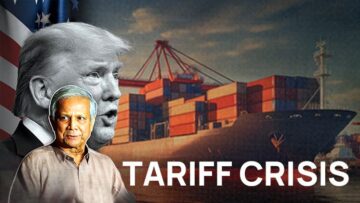
Bangladesh Commerce Minister Tipu Munshi recently announced the export target for the current fiscal year and it is set at US $ 48 billion – US $ 41 billion export target from goods and US $ 7 billion from the services sector. He announced the target through a virtual press briefing, attended by Salman F Rahman, Private Sector Industry and Investment Adviser to the Prime Minister Sheikh Hasina and business leaders of the country.
For the readymade garment sector of the country, export earnings’ target has been set at US $ 33.37 billion for FY21, which is 20.88 per cent higher than the earnings of US $ 27.95 billion in FY20.
“For FY21, we have set an export target of US $ 41 billion with a 21.75 per cent growth from goods and US $ 7 billion from the services sector,” Tipu Munshi maintained, adding the targets were set based on the global economic situation and impacts of COVID-19 on the global supply chain, as well as the Government’s stimulus package announced to cushion the fallout of the pandemic.
The Commerce Minister further said that the export target would be revised after 6 months after analysing the performance and global economic scenario.
It may be mentioned here that for the last FY20, the Government had set the export target at US $ 44.5 billion from goods, but it could earn only US $ 33.67 billion, registering a 16.93 per cent drop in the year.
However, considering the adverse impact of COVID-19 on economies across the globe, many wondered if there would be demand for such volumes of goods between July this year and June next year, as the target is 21.75 per cent which is higher than the export earnings of US $ 33.67 billion logged in last fiscal year when normalcy prevailed for a substantial period of time. On the contrary, this fiscal year started on a disastrous note, thanks to coronavirus, and no one really knows how long uncertainty would prevail on account of the same. But one thing is but sure and as is evident from the target of the apparel sector – the Government would be relying primarily on the apparel industry, which typically accounts for lion’s share of the country’s yearly export earnings, to pull off the goal, which is US $ 5.5 billion lower than fiscal 2019-20’s target of US $ 45.5 billion.
But will it be possible?
As per the Commerce Minister, the decrease in global demand for various products following the coronavirus outbreak was taken into consideration while setting the target. “The target is achievable as it is not overly ambitious,” Tipu Munshi said, adding since stores in the US and the EU have started to reopen and export orders, especially for garments, are on the rebound.
It may be mentioned here that export revenue in the apparel industry witnessed a year-on-year decline of 18.29 per cent in March, 82.85 per cent in April and 61.57 per cent in May, as economies were under lockdowns in a bid to curb the spread of coronavirus. However, as restrictions were being lifted, export earnings picked up as receipts of US $ 2.71 billion were recorded in June, just 2.5 per cent less than what it was during the same period the previous year, while between July 1-18, apparel exports stood at US $ 1.57 billion, which was US $ 1.78 billion in first 18 days of July last year.
However, as of the target for FY21, business leaders maintained the same could be achieved, only if the Government provides necessary policy support to the exporters. “The Government-set export earnings target for FY21 is achievable, but there are two conditions needed to be fulfilled to achieve it. One is that the Government will have to allocate low-cost funds for the workers’ payment for 3 more months, and the other is it will have to ensure easy access to the stimulus package announced by the Prime Minister for the industry,” explained Dr. Rubana Huq, President, Bangladesh Garment Manufacturers and Exporters Association (BGMEA).
As far as the funds to pay workers’ salaries for another 3 months is concerned, the Government has already announced another stimulus package worth Taka 3,000 crore for the export-oriented industries to help them provide wages and salaries to their workers for July. This is the third stimulus package for the export-oriented industries, which have now been actively running their units since March.
The development comes after the BGMEA and the Bangladesh Knitwear Manufacturers and Exporters Association (BKMEA), whose members generate most of the export receipts, jointly wrote to Finance Minister AHM Mustafa Kamal on 22 June, seeking continuation of low-cost loans for 3 more months to September.
Rubana, in the meantime, maintained that if COVID-19 has created hurdles and challenges for the garment exporters of Bangladesh, it has also given rise to some opportunities. “Chinese exports to the US have decreased by 52 per cent, and if we can capture a portion of the business, Bangladesh’s exports will increase significantly,” the BGMEA President said, but also added that policy support for the small and medium enterprise is very much needed, as they were not getting access to stimulus packages and proposed developing a workers’ assistance scheme.
It may be mentioned here that there were reports of how many small and medium-level manufacturers were unable to avail assistance from the Prime Minister’s relief package owing to the multiple riders attached to it.
Meanwhile, Mohammad Hatem, First Vice President, BKMEA, demanded a 20-per cent cash incentive on RMG export to achieve the Government-set export target for FY21. He said it would be possible to achieve the export target if the Government provided policy support, as both prices of and demand for products shrank in the global market.
Underlining that the export target for the current financial year is achievable provided all the stakeholders worked collectively, Sheikh Fazle Fahim, President, Federation of Bangladesh Chambers of Commerce and Industry (FBCCI), said his organisation was working to ensure SMEs and entrepreneurs of promising sectors get easy access to the stimulus package to fight against the COVID-19 fallout, while FBCCI Vice President Md. Siddiqur Rahman, on his part, called for a low-cost fund for the RMG sector to pay workers’ wages for 3 more months.
“The Government provided a low-cost fund of Taka 5,000 crore to pay wages for April, May and June to the export sector’s workers, but the sector needs allocation for 3 more months,” Siddiqur maintained adding that the Government provided up to 20 per cent cash incentive against export of some of the products, but the performance of those products were not satisfactory.
The Government should investigate whether the incentive was misused, he said.
Agreeing that collective efforts of all stakeholders are a must, Salman F Rahman maintained that the Commerce Ministry has rightly estimated a high target and it would be achievable. “It is possible to achieve more than the target, as the pandemic not only posed challenges, but has also created a huge opportunity,” said Salman, adding COVID-19 has also created an opportunity to tap the export market of personal protective equipment and IT.
It may be mentioned here that Salman recently admitted that there was a huge opportunity to tap the global PPE market, but local suppliers were not able to exploit the full potential due to the lack of international-standard testing facilities in the local laboratories. “We are trying to create testing facilities soon so that the local manufacturers can export PPE and masks in a high volume to grab the global market which has emerged,” Salman said, adding, “We are in talks with some international testing companies for conducting tests locally.”
The Government is currently working to conduct tests of the exportable PPE and masks under the Industry Ministry’s accredited body, since it has international recognition, he said. “If we can make our own accreditation body functional, soon we can export the PPE and masks easily on a massive scale to the international markets,” Salman explained.
The coronavirus pandemic has created a market for PPE, masks, gowns, medical textiles and isolation fabrics worldwide worth a few billions of dollars and some local garment manufacturing companies have already started exporting those, as demand has soared across the world. A case in point is Beximco, which reportedly invested around US $ 30 million in their PPE unit in March, and is currently producing 50 million different types of protective gear, including masks and gowns. Further, the company has also signed an agreement with the US Federal Emergency Management Agency (FEMA) to supply washable long sleeve gowns. The deal was completed through the American clothing company Hanesbrands. Beximco received an order of 20 million such products worth about 250 million in April.
Now if Bangladesh would be able to exploit the opportunities that exist in the global market for PPE or would be able to grab business that is moving out of China and further its chances towards achieving the export target of FY21, which many believe could be a daunting task, remains to be seen.






